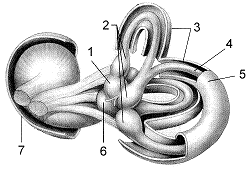Bees C and D differ from bees E and F because ____
a. bees C and D had a different father than bees E and F
b. bees C and D had a different mother than bees E and F
c. bees C and D inherited different alleles than bees E and F from their mother
d. bees C and D inherited different alleles than bees E and F from their father
e. bees C and D are haploid drones while bees E and F are diploid female workers
C
You might also like to view...
In the Hardy-Weinberg equations, the frequencies of 2 alleles in a population (where there are only 2 alleles to consider) can be designated as
A. (p + q)2. B. 2pq. C. p2 and 2pq. D. p2 and q2. E. p and q.
Which of the following does NOT cycle
through an ecosystem? a. water b. carbon c. energy d. phosphorus e. nitrogen
The structures labeled 2 in Figure 43-2 are the:

a. ampullae.
b. cochleae.
c. utricles.
d. semicircular canals.
e. bony labyrinth
Which statement below provides an explanation of why a lagging strand (rather than two leading strands) exists during DNA replication?
a. New nucleotides can be added only to a 3? (–OH) end. b. Only one primer can exist at a time. c. There is only one DNA polymerase per cell. d. There is only one replisome per cell.